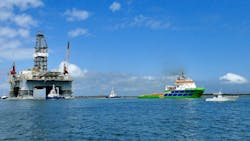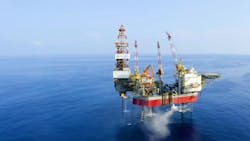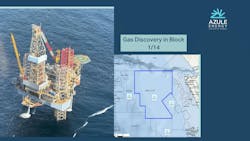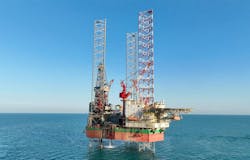Offshore names its Top 5 oil and gas discoveries of the year
Key Highlights
- Technological advances such as high-resolution seismic imaging and extended-reach drilling were vital to these leading discoveries.
- A notable trend is the shift towards gas-heavy plays, supporting LNG export strategies and energy transition goals.
- While deepwater discoveries dominate in reserve size, shallow-water finds leverage existing infrastructure for faster commercialization.
Bruce Beaubouef, Managing Editor
Operators and producers have announced a number of new oil and gas discoveries this year, ranging from the always-desired “large elephants” – traditionally those fields holding more than 500 million or more barrels of oil – to smaller and medium-sized fields. In today’s never-ending search for energy, none are unimportant.
But to place this year’s discoveries in context, Offshore has compiled “The Top 5 offshore discoveries of 2025.” These have been based on announcements and preliminary assessments issued through early November 2025, and ranked by estimated recoverable reserves (primarily oil equivalent, in barrels of oil equivalent or boe).
They are, in no particular order:
- Bumerangue (Brazil)
- Huizhou 19-6 (China)
- Wolin East (Poland)
- Gajajeira-01 (Angola)
- Julaiah (Kuwait).
Where exact recoverable figures are preliminary or not fully delineated, gross in-place estimates for have been noted for context, as these often informed initial rankings.
Discoveries were drawn from information provided by major operators like BP, CNOOC, and others, focusing on those with confirmed hydrocarbon columns and commercial potential. Smaller or less quantified finds were excluded from the top tier.
These rankings prioritized confirmed 2025 announcements with the strongest reserve upside, though final recoverable volumes depend on appraisal. The year has seen a surge in Atlantic Margin and Asian deepwater activity, contrasting with smaller Gulf of Mexico increments. For comparison, 2024’s standout was Namibia’s Venus (~3 billion boe recoverable), but 2025 shifts toward gas-heavy plays amid rising global LNG demand.
Below is a detailed overview of this year’s top five discoveries, followed by analysis of some of the trends and industry dynamics that led to these discoveries.
Bumerangue (Brazil)
In August, bp made what it described as a “significant” hydrocarbon discovery at the Bumerangue block, located 404 kilometers (218 nautical miles) off the coast of Brazil, in the pre-salt Santos basin offshore Brazil.
bp said that the discovery marks its “largest in 25 years,” and reinforces the company’s commitment to growing its upstream portfolio and establishing a material, advantaged production hub in Brazil.
bp drilled exploration well 1-BP-13-SPS in a water depth of 2,372 meters. The well was drilled to a total depth of 5,855 meters. The well intersected the reservoir containing a “high-quality” pre-salt carbonate rock with an areal extent of greater than 300 square kilometers.
Subsequent laboratory and pressure gradient analysis confirmed the presence of a ~1,000 meter gross hydrocarbon column including a ~100 meter gross oil column and a ~900 meter gross liquids rich gas-condensate column. bp said that it believes that the carbon dioxide in the reservoir can be managed, given the presence of liquids across the entire hydrocarbon column, the “high-quality” rock properties observed and bp’s “extensive technology and deepwater developments experience.”
bp says that it is continuing laboratory testing and other analysis to determine fluid characteristics, gas-to-oil and condensate-to-gas ratios and an estimate of in-place volumes and will provide an update in “due course.” Planning of appraisal activities is ongoing with well activities expected to commence in early 2027, subject to regulatory approval.
“We are still in the exploration phase for Bumerangue,” said Gordon Birrell, bp’s executive vice president for Production & Operations. “However, initial results and analysis are extremely encouraging as they indicate a very large hydrocarbon column and a significant volume of liquids in the reservoir.” bp says that it is pleased with what it has seen to date, and its confidence in the potential of the field has increased. “We have a team in place and are accelerating work on proposed appraisal activities and potential development concepts, which will include the potential for an early production system,” Birrell added.
bp holds 100% participation in the block with Pré-Sal Petróleo S.A. as the production sharing contract manager.
Huizhou 19-6 (China)
CNOOC has discovered what is deemed to be the largest oil field in integrated clastic sedimentary rock in the eastern South China Sea, with in-place reserves of more than 100 MMtons of oil equivalent.
The Huizhou 19-6 oil field is in average water depths of about 100 m. Its main oil-bearing plays are the Paleogene Enping and Wenchang formations.
Well HZ19-6-3, drilled and completed at a depth of 5,415 m, encountered 127 m of oil and gas pay zones. During testing, the well flowed 413 bbl/d of light crude and 2.41 MMcf/d of gas.
Chief geologist Xu Changgui said: “In recent years, CNOOC has strengthened the research on exploration theory and technology of the deep and ultradeep plays in the South China Sea.”
This discovery, he added, demonstrates “the enormous exploration potential of deep and ultradeep plays in high-temperature and highly active basins offshore China.”
Wolin East (Poland)
CEP Central European Petroleum has announced what it describes as “Poland’s largest-ever oil and gas discovery” off the Baltic Coast.
The discovery was made at the Wolin East 1 (WE1) well in the Baltic Sea, approximately six kilometers offshore from the city of Świnoujście. CEP Central European Petroleum is the Polish arm of Canadian-founded Central European Petroleum.
In a statement in July, the company said that the Wolin East oil discovery is estimated to contain mean recoverable oil, sales gas and natural gas liquids totaling 200 million barrels of oil equivalent (MMboe). The Wolin license in total is estimated to contain more than 400 MMboe of recoverable hydrocarbon resources.
With these estimates, CEP Central European Petroleum said that the oil and gas resources in Wolin East “constitutes the largest conventional hydrocarbon field yet discovered in Poland, and one of the largest conventional oil discoveries in Europe in the past decade.”
Poland’s Undersecretary of State and Chief Geologist Prof. Krzysztof Galos said that if this discovery “is ultimately confirmed, the Wolin East deposit could become the largest oil and associated natural gas field discovered in Poland to date.”
The Aberdeen-based well consultancy Zenith Energy supported the delivery of the well, with services including “a complex rig move, extremely shallow water depth, and challenging drilling conditions in Polish waters.” The jackup rig Noble Resolve conducted the drilling operation.
The “extremely shallow waters” of the Wolin East oil discovery referred to a water depth of just 9.5 meters, or just over 31 feet. Once the drill reached a vertical depth of 2,715 meters, tests confirmed a 62-meter hydrocarbon column and “excellent” reservoir properties for oil and gas production in the Main Dolomite geological formation.
The discovery could sharply boost output and reduce Poland’s reliance on imports. Poland currently imports 95% of its crude. CEP estimates that the new field could more than double national oil production and increase gas output by 20%.
CEP is working with Noble Corp. on drilling operations and is now seeking both Polish and international partners to help develop the site.
Gajajeira-01 (Angola)
In July, Azule Energy announced that it had made a “significant gas and condensate discovery” with the Gajajeira-01 exploration well offshore Angola. This is Angola’s first dedicated gas exploration well, and the reservoir is estimated to hold over 1 trillion cubic feet of gas and up to 100 million barrels of condensate. The discovery aligns with Angola’s strategy to diversify its energy portfolio beyond oil.
The Gajajeira-01 well is sited in Block 1/14 in the shallow waters of the Lower Congo basin, about 60 kilometers off the coast of Angola. The well, spudded in early April in about 95 m of water, encountered gas- and condensate-bearing sandstones in the LO100 Lower Oligocene target.
These findings have confirmed the presence of a working hydrocarbon system and opened up further exploration opportunities in the area. Azule Energy and its partners will continue to assess the find’s potential and will look to determine an optimal development strategy. Drilling continues, with the next target being the last Lower Oligocene interval LO300.
Julaiah (Kuwait)
In January, the Kuwait Oil Company announced a new discovery at its offshore Julaiah field, located in Kuwait’s territorial waters. The Julaiah 2 exploration field, covering over 74 square kilometers, has been estimated to hold around 800 million barrels of medium-density oil and 600 billion standard cubic feet of associated gas, equivalent to 950 million barrels of oil equivalent. The field’s reserves are described as being “high-quality,” with low hydrogen sulfide and carbon dioxide content.
Julaiah is the second major offshore discovery for Kuwait, following the Al-Nokhatha field in 2024.
Key drivers
All five discoveries leveraged some mix of the latest seismic data acquisition methods and drilling techniques to de-risk complex reservoirs, including 4D seismic and full-waveform inversion, and extended-reach drilling. For example, BP’s Bumerangue discovery in Brazil’s Santos basin used high-resolution seismic to map presalt carbonates over 300 km², while CNOOC’s Huizhou 19-6 discovery in the South China Sea relied on ultra-deepwater drilling technology to target clastic reservoirs at depths exceeding 3,000 meters below the seabed.
These technologies reduced exploration risk in high-cost deepwater and ultra-deepwater settings, enabling these operators to pinpoint high-porosity zones with better reservoir connectivity. This is critical for justifying multi-billion-dollar development in some of these discoveries that are located in frontier basins.
Besides technology, another key driver behind these discoveries is the search for energy security or the goal of developing regional hubs. Discoveries like Huizhou 19-6 (China) and Julaiah (Kuwait) reflect national oil companies (NOCs) prioritizing domestic supply to reduce import dependency. BP’s Bumerangue and Azule’s Gajajeira-01 align with plans to develop regional production hubs (e.g., Santos basin, Lower Congo basin).
Rising global energy demand, coupled with geopolitical tensions, has been pushing NOCs and majors to secure large-scale reserves in politically stable or controlled waters. Gas-heavy finds support LNG export strategies, especially for China and Angola, which are targeting Asian and European markets.
Gas-heavy plays
The shift towards gas-heavy plays aligns with a growing demand for LNG to meet energy transition goals; particularly in Asia and Europe, where efforts to replace coal are ongoing. Gas is increasingly seen as a “bridge fuel” in the energy transition, with LNG contracts offering stable long-term cash flows. The International Energy Agency notes that there has been a four percent increase in global LNG demand in 2025, which in turn has driven exploration toward gas-havey basins like the Lower Congo and South China Sea. This shift is evident in Gajajeira-01 (1 Tcf gas + condensate) and Huizhou 19-6 (significant gas yield).
There are several development advantages for gas reservoirs: they often require less complex enhanced recovery techniques than heavy oil, lowering development costs. Many 2025 discoveries have targeted gas-prone formations (e.g., Oligocene sandstones, deep clastics) due to their prevalence in underexplored deepwater basins. Gas reservoirs also tend to have higher recovery factors (60–80%) than oil (30–50%), which improves field economics. Gas is also favored as a lower-carbon fossil fuel, with operators like BP and Eni integrating finds into decarbonization strategies.
Still, there are challenges with gas-heavy field development, and this will be true for some of the Top 5 discoveries as well. For example, high CO₂ levels in pre-salt gas (e.g., Bumerangue) will require costly separation and reinjection systems, impacting commerciality. And gas finds in frontier areas such as Gajajeira-01 need LNG plants or pipelines, delaying first production compared to oil tiebacks.
Oil-heavy finds like Bumerangue remain critical for liquid fuel demand (e.g., aviation, petrochemicals), but gas’s lower development complexity and cleaner profile make it a priority for operators that need to balance ESG pressures and profitability.
Geological diversity
The top five discoveries span varied geologies: pre-salt carbonates (Bumerangue), clastic deepwater reservoirs (Huizhou 19-6), dolomite formations (Wolin East), and Oligocene sandstones (Gajajeira-01). Julaiah builds on known Cretaceous plays in the Persian Gulf.
Operators are targeting frontier or underexplored plays to unlock “stranded” reserves, using improved geological models. For example, Wolin East’s shallow-water dolomite find in the Baltic Sea opens a new play in a mature region, while Angola’s Gajajeira-01 extends Lower Congo basin potential.
Shallow water versus deepwater
Wolin East (Poland, 9.5 m water depth) and Julaiah (Kuwait, Persian Gulf, <100 m) are in shallow waters, reflecting lower-cost exploration in mature or semi-mature basins. These finds benefit from proximity to existing infrastructure, reducing capex for tiebacks.
In deepwater and ultra-deepwater, Bumerangue (Santos basin, ~2,000–2,500m water depth), Huizhou 19-6 (South China Sea, >1,500m), and Gajajeira-01 (Lower Congo, ~95m but trending toward deeper plays) dominate the larger reserve finds. Deepwater accounts for ~70% of 2025’s offshore reserve additions by volume, per industry reports.
Deepwater discoveries dominate in reserve size due to larger trap sizes and untapped geological potential (e.g., pre-salt, deep clastics). However, shallow-water finds like Wolin East are critical for smaller nations or operators seeking quick-to-market production.
As has been true for years, deepwater projects require higher upfront investment (e.g., $5–10 billion for Bumerangue’s hub development) but offer economies of scale for majors like BP and CNOOC. Shallow-water finds, like Julaiah, leverage existing platforms, enabling faster commercialization for NOCs like Kuwait Petroleum Company.
Well depth trends
Two of the discoveries had very deep wells, as compared with industry standards. The Bumerangue discovery was drilled to ~6,000–7,000 m below the seabed in the pre-salt layers, among the deepest wells drilled in 2025. Pre-salt targets often require total vertical depths (TVD) of 5,000–8,000 m, pushing drilling tech limits.
The Huizhou 19-6 discovery targeted ultra-deep clastic reservoirs at ~3,000–4,000 m below seabed, deeper than typical South China Sea wells (2,000–3,000 m). CNOOC’s use of high-pressure, high-temperature (HP/HT) drilling technology played a key role here.
The three other discoveries had well depths that were comparable to industry standards. The Wolin East discovery entailed shallower sub-seabed depth (~2,000–2,500 m) in dolomite formations, aligning with standard depths for Baltic Sea carbonates. The Gajajeira-01 disocvery was drilled to a depth of ~3,500 m below the seabed in Oligocene sandstones, typical for Lower Congo Basin but deeper than earlier regional discoveries. The Julaiah discovery was likely ~2,500–3,500 m below the seabed, consistent with Persian Gulf Cretaceous reservoirs, and not notably deeper than historical norms.
For historical context, pre-2020, offshore wells typically targeted 2,000–4,000 m below the seabed in conventional plays. Post-2020, deepwater and ultra-deepwater wells increasingly reached 5,000–8,000 m TVD, driven by pre-salt and ultra-deep clastic plays (e.g., Brazil, Guyana). Bumerangue and Huizhou 19-6 pushed the upper end of this range, reflecting a trend toward deeper, more complex reservoirs. Wolin East and Julaiah align with standard depths for their regions, showing a mix of frontier and conventional exploration.
Deeper wells require advanced HP/HT drilling rigs and managed pressure drilling systems, increasing costs but unlocking high-volume reservoirs. For example, Bumerangue’s 500 m hydrocarbon column justifies the technical challenge.
Common denominators
Many of the Top 5 discoveries of 2025 share a number of common denominators. A number of them reflected a drive for national energy security. Other discoveries in gas-heavy plays reflected a desire to meet the needs of the growing international LNG market or energy transition goals. Gas-heavy discoveries (Gajajeira-01, Huizhou 19-6) cater to LNG markets, with higher recovery factors and transition appeal, though CO₂ and infrastructure challenges persist. As has been traditional for years, deepwater fields offer larger reserve estimates (Bumerangue, Huizhou 19-6), but shallow-water finds (Wolin East, Julaiah) offer faster commercialization.
About the Author
Bruce Beaubouef
Managing Editor
Bruce Beaubouef is Managing Editor for Offshore magazine. In that capacity, he plans and oversees content for the magazine; writes features on technologies and trends for the magazine; writes news updates for the website; creates and moderates topical webinars; and creates videos that focus on offshore oil and gas and renewable energies. Beaubouef has been in the oil and gas trade media for 25 years, starting out as Editor of Hart’s Pipeline Digest in 1998. From there, he went on to serve as Associate Editor for Pipe Line and Gas Industry for Gulf Publishing for four years before rejoining Hart Publications as Editor of PipeLine and Gas Technology in 2003. He joined Offshore magazine as Managing Editor in 2010, at that time owned by PennWell Corp. Beaubouef earned his Ph.D. at the University of Houston in 1997, and his dissertation was published in book form by Texas A&M University Press in September 2007 as The Strategic Petroleum Reserve: U.S. Energy Security and Oil Politics, 1975-2005.






